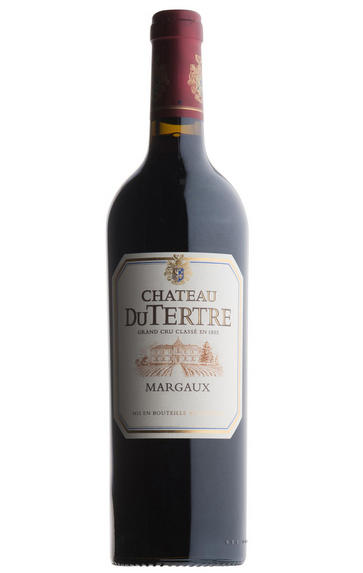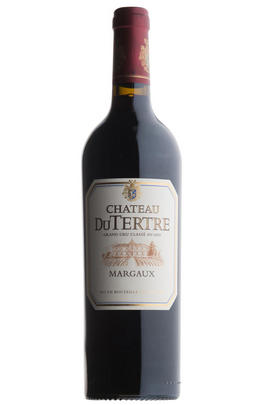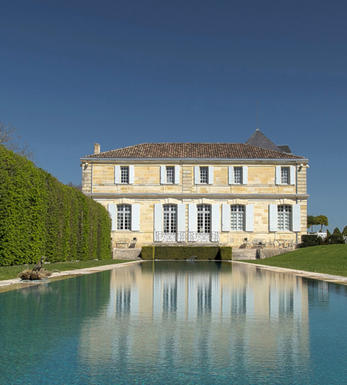
2022 Château du Tertre, Margaux, Bordeaux

Critics reviews
Jane Anson, janeanson.com (May 2023)
William Kelley, Wine Advocate (April 2023)
Blackish purple. Super-ripe nose. Rather cool-tasting! Lots of fruit concentration and a fair amount of obvious, very slightly rustic tannin on the end. Just a bit more jagged in texture and workmanlike than a typical Margaux.
Drink 2029-2043
Jancis Robinson, jancisrobinson.com (April 2023)
This is really clear and bright. Medium- to full-bodied with a solid tannin structure. Tight layers of phenolics to this. Racy and long finish. Firm and focused. 57% cabernet sauvignon, 23% cabernet franc, 15% merlot and 5% petit verdot.
James Suckling, jamessuckling.com (April 2023)
A big, raw, exuberant, incredibly promising barrel sample, the 2022 Château Du Tertre reveals a vivid purple hue as well as full-bodied aromas and flavors of crème de cassis, spring flowers, and graphite. A blend of 57% Cabernet Sauvignon, 23% Cabernet Franc, and the rest Merlot and Petit Verdot, this terrific Margaux has fine tannins, beautiful balance, and a great finish. The cellar will be your friend here.
Jeb Dunnuck, jebdunnuck.com (May 2023)
About this WINE

Chateau du Tertre
Château du Tertre in Margaux was in the 1990s a prime contender for the prize of the least-known Classed Growth wine in the Médoc. It was bought by the Dutch businessman, Eric Albada Jelgersma, in 1997 with a mission to revitalise the estate's fortunes. Château du Tertre's revival was first signalled with its stunning offering from the 2000 vintage and this has continued with equally strong offerings from 2005 and 2008 and 2009.
Château du Tertre can trace its history back to the 12th century, has 50 hectares of vineyards which neighbour those of Cantenac-Brown and Brane-Cantenac to the north and Giscours to the east.
It is situated on one of the highest hills in the Margaux commune which is where its name comes from (Tertre means knoll). The wines is typically a blend of 45% Cabernet Sauvignon, 45% Merlot and 10% Cabernet Franc - Previously the wine's ageing capacity was suspect but examples from recent vintages will age easily for 15 or more years.

Margaux
If Pauillac can be seen as the bastion of ‘traditional’ Red Bordeaux, then Margaux represents its other facet in producing wines that are among Bordeaux’s most sensual and alluring. It is the largest commune in the Médoc, encompassing the communes of Cantenac, Soussans, Arsac and Labaude, in addition to Margaux itself. Located in the centre of the Haut-Médoc, Margaux is the closest of the important communes to the city of Bordeaux.
The soils in Margaux are the lightest and most gravelly of the Médoc, with some also containing a high percentage of sand. Vineyards located in Cantenac and Margaux make up the core of the appelation with the best vineyard sites being located on well-drained slopes, whose lighter soils give Margaux its deft touch and silky perfumes. Further away from the water, there is a greater clay content and the wines are less dramatically perfumed.
Margaux is the most diffuse of all the Médoc appelations with a reputation for scaling the heights with irreproachable wines such as Ch. Margaux and Ch. Palmer, but also plumbing the depths, with too many other châteaux not fulfilling their potential. There has been an upward shift in recent years, but the appellation cannot yet boast the reliability of St Julien. However, the finest Margaux are exquisitely perfumed and models of refinement and subtlety which have few parallels in Bordeaux.
Recommended Châteaux: Ch. Margaux, Ch. Palmer, Ch. Brane-Cantenac, Ch. Rauzan-Ségla , Ch. Dufort-Vivens, Ch. Ferrière, Ch. du Tertre, Ch. Giscours, Ch. d'Angludet.

Cabernet Sauvignon Blend
Cabernet Sauvignon lends itself particularly well in blends with Merlot. This is actually the archetypal Bordeaux blend, though in different proportions in the sub-regions and sometimes topped up with Cabernet Franc, Malbec, and Petit Verdot.
In the Médoc and Graves the percentage of Cabernet Sauvignon in the blend can range from 95% (Mouton-Rothschild) to as low as 40%. It is particularly suited to the dry, warm, free- draining, gravel-rich soils and is responsible for the redolent cassis characteristics as well as the depth of colour, tannic structure and pronounced acidity of Médoc wines. However 100% Cabernet Sauvignon wines can be slightly hollow-tasting in the middle palate and Merlot with its generous, fleshy fruit flavours acts as a perfect foil by filling in this cavity.
In St-Emilion and Pomerol, the blends are Merlot dominated as Cabernet Sauvignon can struggle to ripen there - when it is included, it adds structure and body to the wine. Sassicaia is the most famous Bordeaux blend in Italy and has spawned many imitations, whereby the blend is now firmly established in the New World and particularly in California and Australia.


Buying options
Add to wishlist
Description
The replanting programme undertaken by the previous owners is now coming into full production, and a change in the hierarchy affords director Cynthia Capelaere a little more freedom. The stars have thus aligned for Du Tertre to create a delicious 2022, even if it is a slightly atypical Margaux. Given its quality this year, the Cabernet Franc plays a more important role, delivering bright, pure and grassy fruit aromas and some tension to the tannins. Cynthia thinks the Cabernet Sauvignon is their best ever. The palate has a fine, creamy texture, with Petit Verdot adding a pinch of seasoning.
Cabernet Sauvignon 57%; Cabernet Franc 23%; Merlot 15%; Petit Verdot 5%
Drink 2028-2045
Score: 16.5/20
Berry Bros. & Rudd (April 2023)
wine at a glance
Delivery and quality guarantee